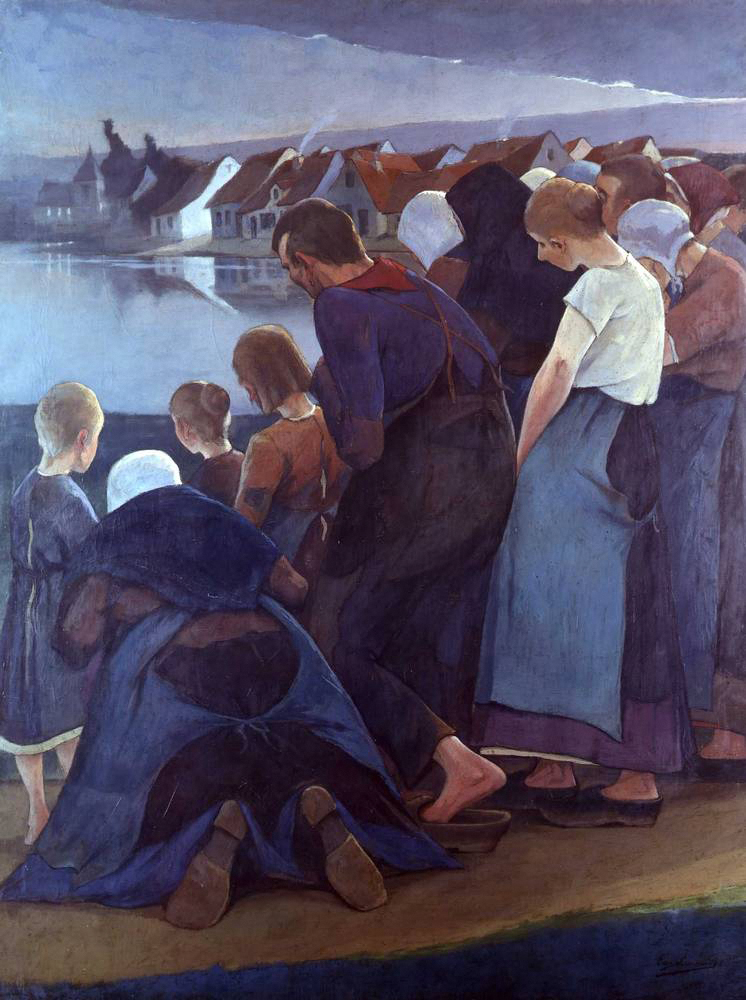
99. Eugène Laermans, The Prayer
| Artist | Eugène Laermans, Belgian, Brussels 1864–Brussels 1940 |
| Title, Date | The Prayer (La prière), mid-1890s |
| Medium | Charcoal on tan paper |
| Dimensions | 12 3/16 × 11 in. (30.9 × 27.9 cm) |
| Inscriptions + Marks | Lower left: La prière – (croquis) | Lower right: E.L. | Bottom center: 8 de large |
| Provenance | Sale, De Vuyst, Lokeren, Belgium, March 4, 2000, no. 205; [Galerie Maurice Tzwern, Brussels, until 2007; to Weisberg]; Yvonne and Gabriel Weisberg, Minneapolis |
| Exhibition History | "Reflections on Reality: Drawings and Paintings from the Weisberg Collection," Mia, 2022–23 |
| Credit Line | Promised gift of Gabriel P. and Yvonne M.L. Weisberg, Minneapolis |
This drawing reflects Eugène Laermans’s deep religious piety. It is preparatory to his painting The Evening Prayer (Das Abendgebet), in the Galerie Neue Meister in Dresden, Germany (fig. 1).1 Both works date to the mid-1890s.2 The intent of this humble group is suggested in the painting, where the faces of the two children at the left are aglow in portentous angelic light. Laermans also singled out the young woman at the right, painting her in lighter colors than the figures around her.

Laermans’s almost sculptural approach in this drawing emphasizes the strength of the villagers. Physique, body language, and costume—not face—are used to express the figures’ demeanor and age. Laermans amplified this mode of expression in the painting. Also in the finished work, he sweetened the scene by adding the children and replacing the windswept trees of the background with a cluster of cozy homes and a church. Both drawing and painting convey the sense of quiet that is typical of Laermans’s art, a tendency that may relate to the loss of hearing in his youth.
In both works, the grouping reflects Laermans’s abiding interest in sixteenth-century Flemish master Pieter Bruegel the Elder, whose depictions of peasants resounded in Netherlandish art for generations. Other realists admired Bruegel as well; one might even think of a Bruegel revival.3 In developing a style that reflected past tradition but in an original way, Laermans remains one of the most significant artists of his time.
GPW
Notes
Staatliche Kunstsammlungen Dresden (inv. 2543). This painting was previously thought to have been destroyed during World War II, but it appears in the SKD online catalogue; https://skd-online-collection.skd.museum/Details/Index/265945 ↩︎
The painting has long been dated to 1896, but the SKD online catalogue says it is probably from 1894. See Gustave Vanzype, “Eugène Laermans” in Collection des Artistes Belges Contemporains (Brussels: Librairie d’Art et d’Histoire, G. Van Oest et Cie, 1908). Also reproduced in L’Art et les Artistes 7 (1908), p. 48, as La Prière du soir; https://skd-online-collection.skd.museum/Details/Index/265945 ↩︎
The idea of a Bruegel revival has been discussed and preliminarily explored by students at the University of Minnesota. It may prove to be a rewarding direction for further research. ↩︎